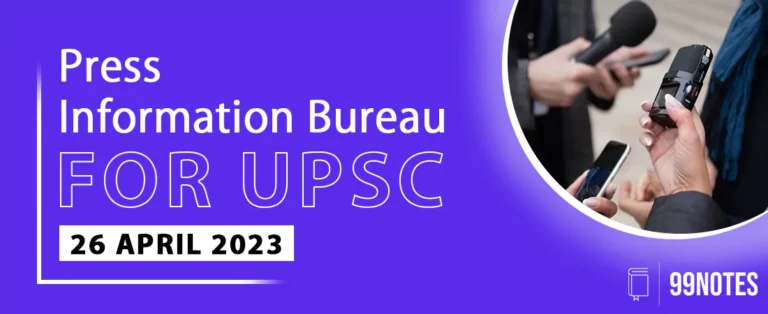3 August 2023 : PIB
PRESS INFORMATION BUREAU
- PRESS INFORMATION BUREAU
- 1. Prime Minister reiterates commitment to bring cutting-edge technology.
- 2. Union Minister Dr Jitendra Singh says, India is the fifth amongst spacefaring nations having end-to-end capabilities
- 3. Union Minister Dr Jitendra Singh says, the Government is exploring the options of collaborating with other countries and taking up indigenous development of Small Modular Reactors (SMRs)
- 4. Rajya Sabha passes Jan Vishwas (Amendment of Provisions) Bill, 2023 in Parliament.
- 5. Digital India initiative of Government has revolutionized education access in rural areas
- 6. SVAMITVA Scheme
- For Enquiry
3-August -2023
Daily Current Affairs For UPSC ,The PIB ( Press Information Bureau )
1. Prime Minister reiterates commitment to bring cutting-edge technology.
Topic: GS3 – Technology development.
Context:
- India’s Prime Minister, Shri Narendra Modi, reiterated commitment to bringing cutting-edge technology to every part of the country.
- Over 3 lakh (300,000) 5G sites have been successfully installed in several districts.
- The installation of these 5G sites represents a landmark achievement in India’s technological journey.
- India now boasts the world’s second-largest 5G ecosystem, as highlighted by Union Minister Shri Ashwini Vaishnaw.
Importance of bringing cutting-edge technology to India:
- Accelerates economic growth and development
- Fosters innovation and research
- Enhances global competitiveness
- Improves productivity and efficiency across industries
- Creates job opportunities and skilled workforce
- Facilitates better healthcare, education, and public services
- Strengthens national security and defense capabilities
- Bridges the digital divide, promoting inclusivity
- Attracts foreign investments and collaborations
- Positions India as a leader in the global tech landscape.
Challenges:
- Infrastructure Development: Upgrading existing infrastructure and building new ones to support advanced technologies can be costly and time-consuming.
- Digital Divide: Ensuring equitable access to technology in rural and remote areas, as well as among underserved communities, is a significant challenge.
- Skill Gap: Nurturing a skilled workforce capable of understanding, operating, and maintaining cutting-edge technologies is essential but can be challenging to achieve.
- Cybersecurity: With increased technological adoption, the risk of cyber threats and data breaches also rises, necessitating robust cybersecurity measures.
- Regulatory Framework: Adapting laws and regulations to keep pace with evolving technology can be complex and may require a delicate balance between innovation and privacy/security concerns.
- Interoperability and Standards: Ensuring compatibility and adherence to international standards across various technologies can be a hurdle.
- Cost and Affordability: The high cost of adopting and implementing new technologies may pose financial challenges for businesses and individuals.
- Environmental Impact: Some cutting-edge technologies can have environmental consequences that need to be addressed responsibly.
- Dependence on Imports: Reliance on foreign technology providers can present challenges related to data sovereignty and technological sovereignty.
- Ethical Considerations: The use of emerging technologies like AI and automation raises ethical questions that require thoughtful consideration.
Way forward:
- Investment in Research and Development: Encourage public and private investment in research and development to foster innovation and create homegrown cutting-edge technologies.
- Digital Infrastructure Development: Focus on building robust and reliable digital infrastructure, including high-speed internet, to support the seamless adoption of advanced technologies.
- Skill Development and Education: Promote skill development programs and incorporate technology-focused education to create a skilled workforce capable of leveraging and managing new technologies.
- Public-Private Partnerships: Foster collaboration between the government, private sector, and academia to jointly work on technology projects and initiatives.
- Promote Startups and Entrepreneurship: Create a conducive environment for startups and entrepreneurs to develop and commercialize innovative technologies.
- Regulatory Support: Formulate flexible and forward-looking regulations that encourage technology adoption while addressing security, privacy, and ethical concerns.
- Focus on Cybersecurity: Strengthen cybersecurity measures and create awareness to protect against cyber threats and data breaches.
- Inclusive Technology Adoption: Ensure technology reaches all sections of society, bridging the digital divide and promoting inclusivity.
- Promote Indigenous Solutions: Encourage the use of indigenous technologies and solutions to reduce dependence on imports and enhance technological sovereignty.
- Sustainable Technology: Prioritize sustainable and eco-friendly technologies to minimize environmental impact.
- International Collaboration: Foster collaboration with other countries and participate in international research and development initiatives.
- Public Awareness and Acceptance: Create awareness among the public about the benefits and responsible use of cutting-edge technologies.
- Government Support: Provide financial incentives, grants, and subsidies to incentivize the adoption of cutting-edge technologies by businesses and organizations.
- Adaptability and Flexibility: Embrace a culture of adaptability and flexibility to quickly adopt emerging technologies and respond to market dynamics.
Government initiatives for bringing cutting-edge technology to India:
- Digital India: A flagship program aiming to digitally empower citizens and transform governance through technology.
- Make in India: An initiative promoting indigenous manufacturing and fostering innovation in technology sectors.
- Start-up India: Fostering the growth of start-ups and providing support through funding, incubation, and other resources.
- National Skill Development Mission: Aims to enhance employability and skills of the youth, including technology-related skills.
- Atal Innovation Mission: Encourages innovation and entrepreneurship among students and startups.
- BharatNet: Connecting rural areas with high-speed internet to bridge the digital divide.
- Smart Cities Mission: Transforming cities with advanced technology and digital infrastructure.
- UPI (Unified Payments Interface): A digital payment system facilitating instant and secure transactions.
- National AI Mission: Focusing on research and development of Artificial Intelligence in various sectors.
Model question: Examine the challenges and opportunities in implementing cutting-edge technology in India. How can India ensure inclusive technology adoption while addressing ethical, security, and environmental concerns?
2. Union Minister Dr Jitendra Singh says, India is the fifth amongst spacefaring nations having end-to-end capabilities
Topic: GS3 – Space Technology development.
Context:
- Union Minister of State (Independent Charge) Science & Technology; Atomic Energy and Space, Dr Jitendra Singh today said, India is the fifth amongst spacefaring nations having end-to-end capabilities in space research and development.
ISRO notable achievements:
- 27 satellites and 22 Launch Vehicle missions successfully accomplished.
- Successful Pad Abort Test (PAT) to qualify the Crew Escape System (CES) in July 2018.
- Successful Reusable Launch Vehicle autonomous landing mission in April 2023.
- UNNATI capacity building training program on Nanosatellites benefited 90 participants from 45 countries.
- Chandrayaan-2 mission to the Moon successfully launched in July 2019, providing valuable science data.
- YUVIKA program launched in 2019, with 603 students participating over three years.
- NewSpace India Limited (NSIL) incorporated in 2019 to enhance private sector participation in the space program.
- Space Sector Reforms announced in June 2020 to boost India’s market share in the global space economy.
- Establishment of Indian National Space Promotion and Authorisation Centre (IN-SPACe) to regulate space activities involving non-government entities.
- Vikram-S (Prarambh mission) suborbital launch vehicle successfully accomplished in November 2022.
- Controlled re-entry experiment for decommissioned Megha-Tropiques-1 (MT-1) satellite carried out successfully in March 2023.
- Reusable Launch Vehicle Autonomous Landing Mission (RLV LEX) successfully demonstrated in April 2023.
- LVM3-M4 successfully launched Chandrayaan-3 Spacecraft in July 2023, with a scheduled Moon landing on 23rd August 2023.
3. Union Minister Dr Jitendra Singh says, the Government is exploring the options of collaborating with other countries and taking up indigenous development of Small Modular Reactors (SMRs)
Topic: GS3 – Technology development.
Context:
- The Government is exploring options for collaborating with other countries and undertaking indigenous development of Small Modular Reactors (SMRs).
- The final decision on the future course of action will be based on the Government’s decision.
More information about the news:
- SMRs are seen as a promising technology for industrial de-carbonization, especially in areas requiring reliable and continuous power supply.
- India is committed to clean energy transition and is considering steps for the development of SMRs to fulfill this commitment.
- While the primary goal of the Department is to augment nuclear power capacity through large-size reactors, SMRs offer potential opportunities for clean energy generation in specific contexts.
4. Rajya Sabha passes Jan Vishwas (Amendment of Provisions) Bill, 2023 in Parliament.
Topic: GS2 – Polity polity.
Context:
- The Bill was passed in Lok Sabha on 27th June 2023 and Rajya Sabha on 2nd August 2023.
- It was first introduced in Lok Sabha on 22nd December 2022 and referred to the Joint Committee of Parliament.
Highlights Jan Vishwas (Amendment of Provisions) Bill:
- The Bill proposes to decriminalize 183 provisions in 42 Central Acts administered by 19 Ministries/Departments.
- Decriminalization will be achieved through the removal of imprisonment and/or fine, introduction of compounding of offences, and conversion of imprisonment and fine to penalties in some provisions.
- The Bill proposes measures for effective implementation, including pragmatic revision of fines, establishment of Adjudicating Officers and Appellate Authorities, and periodic increase in quantum of fine and penalties.
- The degree and nature of punishment will be commensurate with the severity of the offence.
- The benefits of the Amendment Bill include rationalizing criminal provisions, reducing undue pressure on the justice system, allowing citizens and businesses to operate without fear of imprisonment for minor defaults, and bolstering the growth of businesses.
- The legislation will serve as a guiding principle for future amendments in various laws, saving time and cost for the government and businesses alike.
5. Digital India initiative of Government has revolutionized education access in rural areas
Topic: GS3 – Education.
Context:
- The Ministry of Electronics and Information Technology (MeitY) launched the ‘Digital India’ programme with the vision of transforming India into a digitally empowered society and knowledge-based economy by ensuring digital access, inclusion, empowerment, and bridging the digital divide.
- PM e-Vidya plays a crucial role in offering high-quality educational programs through various digital platforms, benefiting students in rural, tribal, and remote areas.
Summary of Major Education Initiatives under PM e-Vidya:
- DIKSHA: A digital infrastructure providing quality e-content for school education in States/UTs with QR coded Energized Textbooks for all grades.
- DTH Channels: 12 DTH Channels in school education and 22 SWAYAM PRABHA channels in higher education are functional.
- SWAYAM: The national MOOC platform with credit transfer provision to universities for Higher Education Courses.
- PM e-Vidya Banner: All efforts related to digital/online/on-air education to enable multi-mode access to education under Atma Nirbhar Bharat Abhiyaan.
6. SVAMITVA Scheme
Topic: GS2 – Government initiatives.
Context:
- Pilot phase launched on 24th April 2020 for implementation during 2020-21.
- National roll-out of the scheme launched on 24th April 2021.
- Implemented through collaborative efforts of Ministry of Panchayati Raj, State Revenue Department, State Panchayati Raj Department, and Survey of India (SoI).
About SVAMITVA scheme:
- SVAMITVA (Survey of Villages and Mapping with Improvised Technology in Village Areas) is a scheme implemented by the Government of India.
- The scheme aims to provide an integrated property validation solution in rural areas, primarily for rural households.
- It facilitates the issuance of property cards to individual rural property owners.
- The scheme uses drones and modern surveying technology for mapping and surveying land parcels in villages.
- It helps in creating accurate land records and resolving property-related disputes.
- The property cards provided under the scheme are considered legal proof of ownership and can be used for availing various benefits and services.
SVAMITVA scheme implementation faced several challenges, including:
- Availability of sufficient Drones for mapping and surveying purposes.
- Delay in providing sufficient number of Chuna Marked villages by States.
- Insufficient trained manpower to carry out the scheme activities.
- Extreme weather conditions in certain areas.
- Difficult terrain in some States, affecting the progress of the scheme.
- Delay in obtaining drone flying permission in areas around airports and international borders.
These issues were addressed through:
- Regular monitoring of the scheme’s progress.
- Intervention and coordination with line Departments and organizations involved.
- Handholding and providing support to different stakeholders of the scheme.
For Enquiry

3 August 2023 : PIB

Prelims : 2 Aug 2023 : Daily Answer Writing

Prelims : 1 Aug 2023 : Daily Answer Writing

Mains : 2 August 2023 : Daily Answer Writing

2 August 2023 : Daily Quiz

2 August 2023 : PIB

2 August 2023 : The Hindu Editorial Notes PDF

2 August 2023 : Daily Current Affairs

Mains : 1 August 2023 : Daily Answer Writing

1 August 2023 : Daily Quiz
PIB 3 August 2023 : PIB PRESS INFORMATION BUREAU
1-August -2023
Daily Current Affairs For UPSC ,The PIB ( Press Information Bureau…
prelims answer writing Prelims : 2 Aug 2023 : Daily Answer Writing Prelims Answer Writing
One of the key components of these exams is the written test, which consists of…
prelims answer writing Prelims : 1 Aug 2023 : Daily Answer Writing Prelims Answer Writing
One of the key components of these exams is the written test, which consists of…
mains answer writing Mains : 2 August 2023 : Daily Answer Writing DAILY Answer Writing
One of the key components of these exams is the written test, which consists of…
Daily Quiz 2 August 2023 : Daily Quiz 2 August 2023 : Daily Quiz…
PIB 2 August 2023 : PIB PRESS INFORMATION BUREAU
2-August -2023
Daily Current Affairs For UPSC ,The PIB ( Press Information…
The Hindu 2 August 2023 : The Hindu Editorial Notes PDF The Hindu Editorial
2-August-2023
Daily Current Affairs For UPSC ,The Hindu Editorial Summary
Facebook-f
Twitter
Youtube
1. The…
Daily Current Affairs 2 August 2023 : Daily Current Affairs DAILY CURRENT AFFAIRS
Daily Current Affairs For UPSC ,Daily Current affairs of The hIndu and Indian Express.
2-August-2023
Facebook-f
Twitter
Youtube
1. Patna…
mains answer writing Mains : 1 August 2023 : Daily Answer Writing Mains Answer Writing
One of the key components of these exams is the written test, which consists of…
Daily Quiz 1 August 2023 : Daily Quiz 1 August 2023 : Daily Quiz…





